Uncovering Value: Vintage Artwork Appraisal at Pawn Shops
Uncovering Value: Vintage Artwork Appraisal at Pawn Shops
Discover the hidden worth of vintage artwork by having it appraised by experts at pawn shops. Experienced appraisers blend skill, knowledge, and market trends to reveal the true value of your pieces. Understanding the importance of factors like authenticity, condition, and provenance is key to accurate valuation. Pawn shop appraisers with qualifications, training, and background in art history guarantee precise assessments. By delving into the evaluation process, negotiating fair prices, and documenting artwork properly, you can maximize returns. Uncover the intricate art market insights and appraisal techniques pawn shops offer to fully appreciate your vintage art treasures.
Importance of Vintage Artwork Appraisal
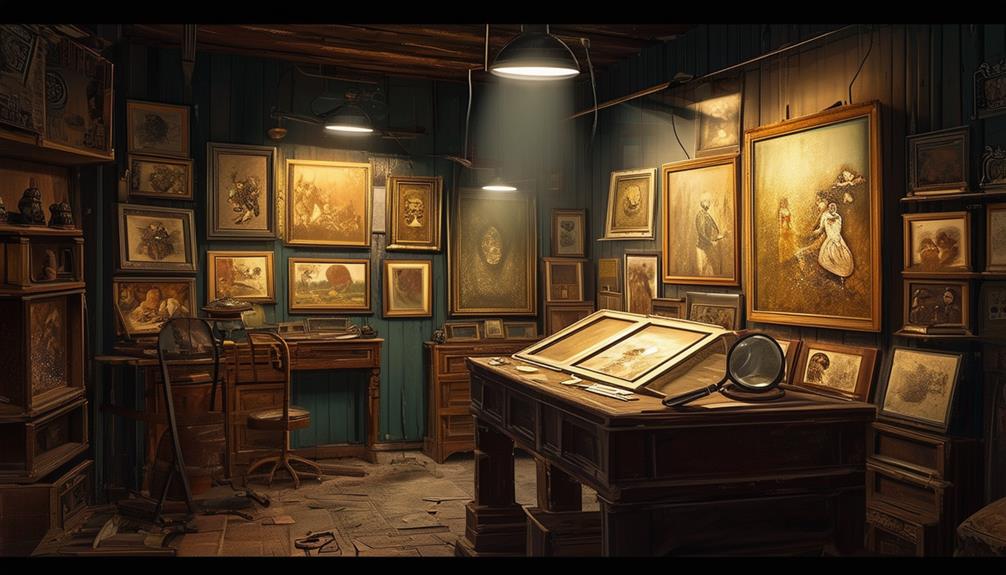
The assessment of vintage artwork holds significant importance in determining its authenticity and market value. Appraisal techniques and authentication methods play a pivotal role in establishing the legitimacy of a piece, ensuring it is not a forgery or replica. By employing these methods, collectors and pawn shops can confidently determine the investment potential of vintage artwork.
Market analysis is another key aspect of appraisal, allowing stakeholders to understand the current demand and trends in the art world. Ultimately, a thorough appraisal process is essential for making informed decisions regarding the buying, selling, or loaning of vintage artwork, safeguarding against potential financial losses and ensuring fair transactions in the art market.
Factors Influencing Artwork Value
When determining the value of vintage artwork, one vital factor is the reputation of the artist behind the piece.
Additionally, the condition of the artwork plays a significant role in gauging its worth.
Artist's Reputation Impact
An artist's reputation greatly impacts the value of their artwork in the vintage market. The artist's legacy, including their body of work and contribution to the art world, plays a significant role in determining the worth of their pieces.
Additionally, provenance importance, which refers to the documented history of ownership and authenticity of the artwork, can further elevate its value. Collectors and buyers often seek out pieces created by well-known artists with established reputations, as these artworks tend to hold more value due to the artist's significance in the art community.
Hence, when appraising vintage artwork at pawn shops, considering the artist's reputation and the provenance of the piece is vital in determining its worth.
Artwork Condition Importance
How does the condition of vintage artwork impact its overall value in the market? The preservation and maintenance of artwork play a vital role in determining its worth. Conservation techniques and restoration methods are employed to make sure that the piece remains in excellent condition, enhancing its value. Proper artwork preservation not only safeguards the piece from deterioration but also maintains its aesthetic appeal, making it more desirable to collectors. Implementing effective maintenance strategies can prevent damage caused by environmental factors or mishandling. By investing in the care of vintage artwork, owners can potentially increase its value over time and secure a higher appraisal in the market.
| Conservation Techniques | Restoration Methods |
|---|---|
| Cleaning | Inpainting |
| Framing | Varnishing |
Market Demand Influence
Market demand profoundly influences the value of artwork in the industry, dictating the level of interest and desirability among collectors and buyers. This influence is driven by various factors that shape market trends and ultimately impact the appraisal of vintage artwork at pawn shops.
Three key influencing factors include:
- Artist Popularity: The fame and recognition of the artist greatly affect the market demand for their artwork.
- Artistic Style: Different artistic styles go in and out of vogue, impacting the desirability and value of artwork created in those styles.
- Historical Significance: Artworks tied to specific historical periods or events often garner higher market demand due to their cultural and historical relevance.
Differentiating Authenticity in Art Pieces
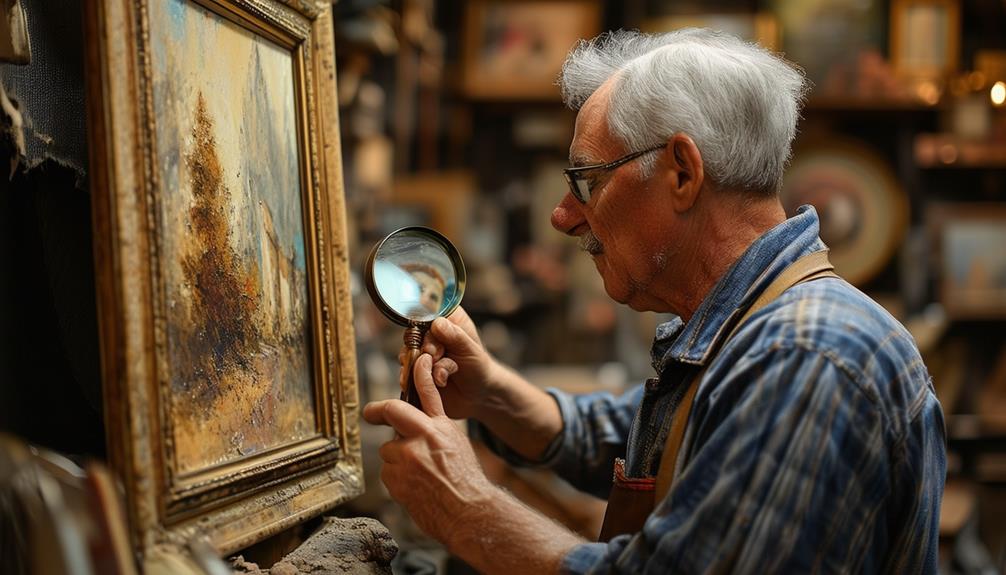
Determining the authenticity of artwork is an essential aspect of the appraisal process in the vintage art market. When evaluating vintage art pieces, experts often explore the art authentication process and keep a close eye on market trends. Vintage art valuation heavily relies on provenance research to establish the authenticity and history of a piece. Art pieces with solid provenance tend to fetch higher prices in the market due to their verified origins. To differentiate between authentic and counterfeit pieces, appraisers look for various markers such as signatures, unique characteristics, and historical documentation. Utilizing advanced techniques like scientific analysis and expert opinions further aids in distinguishing genuine vintage artworks from imitations.
| Authenticity Indicators | Description |
|---|---|
| Signatures | Original artist signs |
| Unique Characteristics | Distinctive features |
| Historical Documentation | Records and archives |
| Scientific Analysis | Carbon dating, materials |
| Expert Opinions | Professional appraisers |
Expertise of Pawn Shop Appraisers
Pawn shop appraisers play an important role in determining the value of vintage artwork. Their qualifications and training are essential factors that contribute to their expertise in evaluating the authenticity and worth of art pieces.
Consistency in their valuations is key to building trust with customers and ensuring fair transactions.
Appraiser Qualifications and Training
When seeking vintage artwork appraisals at pawn shops, it is important to evaluate the qualifications and training of the appraisers to guarantee accurate valuation. Appraiser experience plays a significant role in determining the reliability of their assessments. Look for certifications from reputable appraisal organizations to confirm the appraiser has received proper training in valuing vintage artwork.
Additionally, consider the appraiser's background in art history or fine arts, as this can greatly influence their ability to accurately assess the value of unique pieces. By verifying these qualifications, you can have more confidence in the appraisal provided by pawn shop experts.
- Verify training certification from reputable organizations.
- Consider the appraiser's experience in art history or fine arts.
- Ensure the appraiser has a solid background in valuing vintage artwork.
Consistency in Valuations
Considering the expertise of pawn shop appraisers, the consistency in valuations of vintage artwork is vital for ensuring accurate and reliable assessments. Consistent appraisals help maintain credibility and trust between the pawn shop and their customers. Valuation accuracy is essential in determining fair prices for both buyers and sellers, preventing misunderstandings or disputes. A well-trained and knowledgeable appraiser can provide consistent valuations by staying updated on market trends, attending training sessions, and leveraging their experience. By establishing a reputation for reliable appraisals, pawn shops can attract more clients and build long-lasting relationships based on transparency and fairness.
| Benefits of Consistent Valuations | ||
|---|---|---|
| Ensures credibility and trust | Prevents disputes | Attracts more clients |
| Maintains fair prices | Builds long-lasting relationships | Demonstrates transparency |
Process of Artwork Evaluation
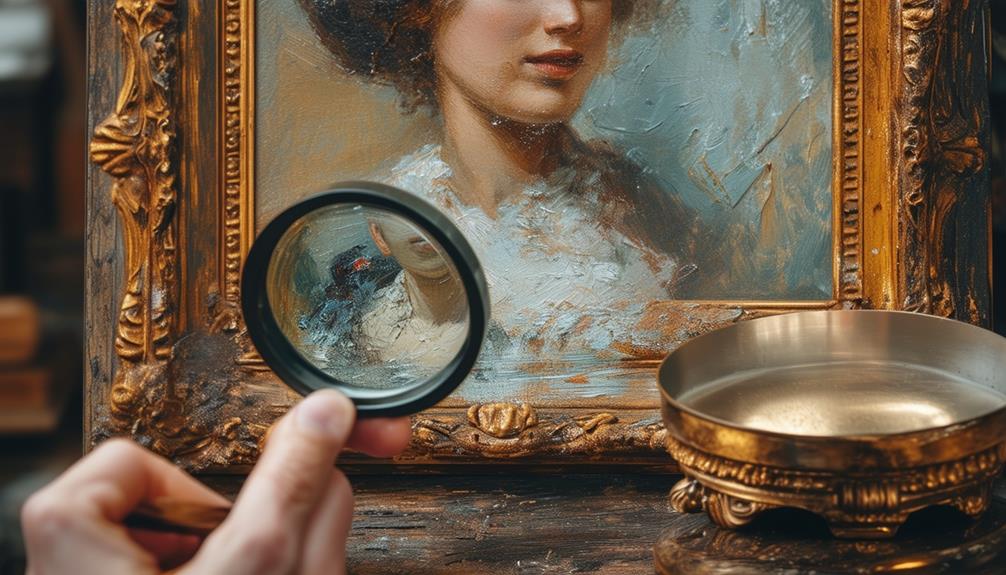
During the process of evaluating artwork, experts carefully examine various factors to determine its authenticity and value. When appraising vintage artwork, specialists typically consider:
- Artwork Provenance: Investigating the history of the piece, including previous owners, exhibitions, and sales records, can provide valuable insights into its authenticity and significance.
- Valuation Methods: Utilizing a combination of approaches such as comparative market analysis, cost approach, and income approach helps assess the monetary worth of the artwork accurately.
- Artistic Characteristics: Evaluating the quality of the artwork, the artist's style, medium used, and the overall condition play an essential role in determining its value in the market.
Evaluating Artwork Condition
When evaluating artwork condition, it is essential to focus on three key points:
- Verifying the authenticity of the piece
- Understanding the fluctuations of the art market
- Recognizing how the condition of the artwork can greatly impact its overall value
Artwork Authenticity Verification
In order to guarantee the authenticity of artwork, it is essential to meticulously evaluate the condition of the piece. When conducting an authenticity verification process using appraisal techniques, consider the following:
- Examination of Materials: Assess the quality and type of materials used in creating the artwork. Variations or inconsistencies may indicate a reproduction rather than an original piece.
- Signature Analysis: Look for the artist's signature or mark on the artwork. Compare it to known signatures or consult experts to verify its authenticity.
- Provenance Research: Investigate the artwork's history and previous ownership. A clear and documented provenance can support the authenticity of the piece.
Understanding Art Market
Understanding the art market involves evaluating the condition of artwork to determine its value and potential worth in the current market. When considering art investment, it's important to assess the historical art prices to gauge trends and predict future value.
Historical art prices provide insights into how certain artists or styles have performed over time, helping investors make informed decisions. Evaluating the condition of artwork involves looking at factors such as any damage, restoration work, or signs of aging. These aspects can greatly impact the overall value of the piece.
Condition Impact on Value
Evaluating the physical condition of artwork is an essential aspect in determining its value and potential worth in the current market. When appraising vintage artwork at pawn shops, the condition impact on value is significant. Factors such as wear and tear, damage, and restoration can greatly affect the artwork's appraisal accuracy. To assess the condition impact effectively, consider the following:
- Signs of Wear and Tear: Scratches, fading, and discoloration can lower the value of the artwork.
- Damage Assessment: Any tears, creases, or water damage can devalue the piece.
- Restoration Quality: The quality of any previous restoration work can impact the overall value of the artwork.
Negotiating Fair Prices for Art
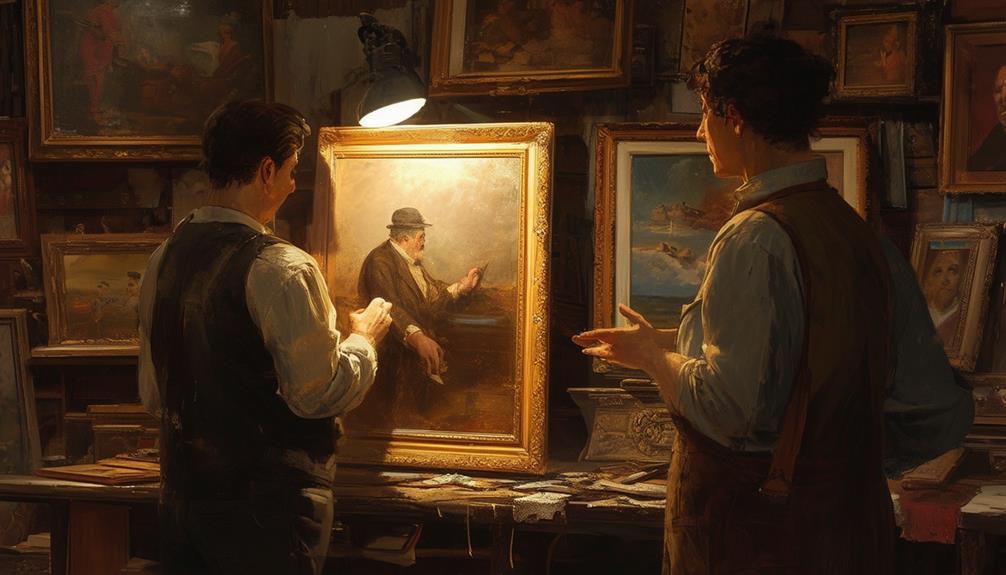
When considering the negotiation of fair prices for art at pawn shops, one key aspect to keep in mind is the artwork's unique qualities and market demand. To negotiate effectively, understanding pricing negotiation tactics and artwork valuation strategies is essential.
Start by researching the artist, the artwork's history, and any relevant market trends. Highlighting any special features or provenance can strengthen your position during negotiations. Be prepared to justify your proposed price with facts and comparisons to similar pieces.
Ensuring Proper Artwork Documentation
To guarantee a smooth and accurate appraisal process, proper documentation of the artwork's history and condition is paramount. When dealing with vintage artwork, ensuring proper provenance and accurate documentation is key. Here are three essential steps to follow:
- Provenance Verification: Collect all available information about the artwork's origin, including past owners, exhibitions, and sales records.
- Condition Report: Document any imperfections, repairs, or alterations on the artwork to provide a thorough overview of its current state.
- Photographic Evidence: Take high-quality photographs of the artwork from different angles to capture its details and condition accurately.
Understanding Market Trends in Art
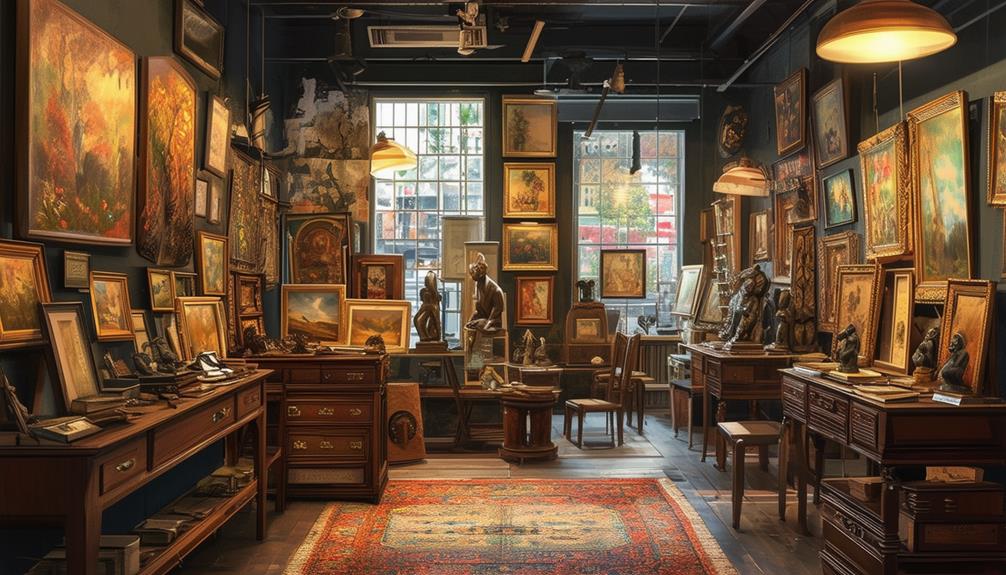
Understanding market trends in art is essential for making informed decisions in the buying and selling of artworks. By staying current with the latest developments in the art world, individuals can better understand the demand for certain styles, artists, or mediums. This understanding allows for more strategic pricing strategies when valuing artworks for sale or purchase.
For instance, knowing which art styles are gaining popularity can help sellers price their pieces competitively, while buyers can use this information to assess whether an artwork is priced fairly. Additionally, being aware of market trends can provide insights into potential investment opportunities within the art market.
Hence, a grasp of art trends and pricing strategies is important for maximizing returns in art transactions.
Maximizing Returns From Art Sales
Exploring effective strategies for maximizing returns from art sales is essential for individuals looking to optimize their investments in the art market. To achieve this goal, consider the following key aspects:
- Marketing strategies: Implementing targeted marketing campaigns can help reach a broader audience, increasing the likelihood of finding the right buyer for your artwork.
- Pricing tactics: Conduct thorough research on current market trends and comparable sales to set a competitive yet profitable price for your artwork.
- Investment potential, Preservation techniques: Assess the long-term investment potential of your artwork and employ proper preservation techniques to maintain its value over time.
Frequently Asked Questions
Can Pawn Shops Appraise Digital Artwork as Well?
Pawn shops can appraise digital artwork, but the process may vary. Authenticity verification is essential for digital art, often requiring specialized knowledge and tools.
Some pawn shops may have experts who can assess the value of digital artwork based on factors like artist reputation, edition number, and provenance. However, due to the intangible nature of digital art, appraisal methods may differ from traditional artwork, emphasizing factors like file authenticity and ownership rights.
Are There Any Restrictions on the Types of Art Pawn Shops Accept?
When it comes to art restrictions at pawn shops, establishments may have varying policies on the types of art they accept. Many pawn shops prioritize authenticating artwork to guarantee its value. Restrictions could include limitations on certain types of art mediums, styles, or even specific artists.
It's essential for pawn shops to have expertise in art authentication to accurately assess the value of the pieces they accept.
How Do Pawn Shops Handle Appraisal of Damaged Artwork?
When dealing with damaged artwork, pawn shops employ a meticulous restoration process that can revive even the most compromised pieces. Utilizing cutting-edge conservation methods, they work diligently to preserve the piece's original integrity while enhancing its aesthetic appeal.
In tandem with this, authentication techniques are employed to verify the artwork's origin and provenance. By staying abreast of market trends, pawn shops guarantee accurate valuations, offering fair prices for both the artwork and the restoration efforts.
What Happens if the Appraisal Value Differs From My Expectation?
If the appraisal value differs from your expectation, a re-negotiation process can be initiated.
This process involves discussing the discrepancies with the appraiser, providing any additional information or documentation to support your valuation, and possibly reaching a new agreement on the value.
Ultimately, the objective is to guarantee customer satisfaction by addressing concerns and finding a resolution that both parties are comfortable with.
Do Pawn Shops Provide Insurance Coverage for Artwork on Consignment?
Pawn shops typically do not provide insurance coverage for consignment artwork. It is important for individuals consigning artwork to inquire about insurance options and guarantee adequate coverage.
While some pawn shops may offer insurance for certain items, it is not a standard practice for consignment artwork. Digital artwork may also be subject to appraisal capabilities, but insurance coverage for such items should be clarified with the pawn shop prior to consignment.
Conclusion
In summary, vintage artwork appraisal at pawn shops is essential for determining the true value of art pieces.
With over 25% of art collectors purchasing art as an investment, it is important to understand the factors influencing the value of artwork.
By working with expert appraisers at pawn shops and staying informed about market trends, individuals can maximize their returns from art sales and guarantee fair prices for their valuable pieces.

